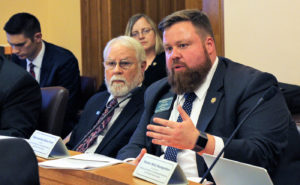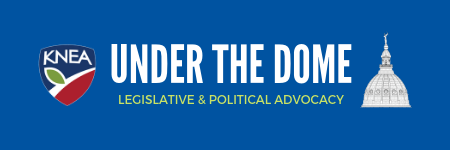
Rep. Blaine Finch, right, speaks during a meeting of a House-Senate committee starting work on the Legislature’s response to a court order on school funding. At left is Rep. Ed Trimmer.
CELIA LLOPIS-JEPSEN / KANSAS NEWS SERVICE
Starting to Talk About a School Finance Fix
The first meeting of the Special Committee on a Comprehensive Response to the School Finance Decision (how’s that for a committee name!) met for the first time yesterday. They will meet again for two days on December 18 and 19 in advance of the 2018 legislative session.
Committee members are Rep. Blaine Finch, Chairman (R-Ottawa), Sen. Molly Baumgardner, Vice-Chair (R-Louisburg), Senators Jim Denning (R-Overland Park), Anthony Hensley (D-Topeka), Carolyn McGinn (R-Sedgwick), and Rick Wilborn (R-McPherson) and Representatives Larry Campbell (R-Olathe), Steven Johnson (R-Assaria), Ed Trimmer (D-Winfield), Troy Waymaster (R-Bunker Hill), and Valdenia Winn (D-Kansas City). As Chairman, Finch runs a tight ship, sticking to the agenda and the timelines specified in the agenda.
Yesterday’s meeting was intended to bring everyone up to speed on the status of school finance with the passage of SB 19 (the Kansas School Equity and Enhancement Act or KSEEA) passed at the end of the 2017 session and the subsequent Supreme Court decision of October 2, 2017, in the Gannon school finance lawsuit. (Click here to see the powerpoint presentation used in the meeting.)
SB 19 created a new school finance formula that is very similar to the formula in effect prior to its repeal in favor of the Brownback block grants (the CLASS Act). It increased school funding by about $292 million. KSEEA also made several modifications to the equity provisions in the school finance law.
The Supreme Court on October 2, 2017, ruled that the KSEEA was unconstitutional both in terms of adequacy and equity. The Court noted that structurally, the bill was constitutional on adequacy but in implementation was unconstitutional. It was noted that the $292 million in new funding was an “outlier” when compared to other analyses – the Plaintiffs averaged the two cost studies done for the legislature and came up with a figure of $1.7 billion, the State Board of Education budget request was for $893 million, and the earlier 3-judge panel calculated $819 million. We should note that the original version of SB 19 as drafted by Rep. Melissa Rooker (R-Fairway) and Sen. Laura Kelly (D-Topeka) would have provided $750 million in new funding over three years.
The Court also found that four changes in the bill made funding less equitable. Specifically, they called out
- a provision expanding the use of capital outlay funds,
- a provision reinstating the protest petition to reach the maximum LOB,
- a provision using the prior year’s LOB to determine equalization aid in the current year, and
- a provision setting a 10% floor for the distribution of at-risk funds.
The Committee spent the morning reviewing all of this Court and legislative history.
In the afternoon, Finch led the committee in a discussion of what remedies might be options available to the legislature and what information the committee members would need to consider those options. Finch made it clear that nothing was off the table. Committee members should feel free to bring any ideas forward and suggesting a possible option would in no way imply an automatic endorsement of that option.
The discussion was guided by a memo from Fiscal Analyst John Hess of the Legislative Research Department (click here to read the memo). It was less about generating alternative options that it was seeking information to guide the committee. Information sought included:
- how much of increased enrollment in our schools is due to virtual schools and students from out of state,
- how much would need to be raised in taxes to meet the higher spending goals,
- if new school funding was not found through revenue increases, what would across the board cuts to other programs look like, and
- what are the implications/challenges of requiring all LOB increases to have been and continue to be subject to a protest petition?
The new data will be used in guiding discussions at the next meeting.
Challenges to KPERS Discussed in Committee
The Joint Committee on Pensions, Investments and Benefits met on Monday, November 27. On the surface, the committee’s agenda was at best perfunctory and at worse a forecast of another four or five hours listening to and digesting reports regarding Bond Proceeds and Valuation charts while sitting on wooden chairs.
But wait, there is more.
In the background of most any meeting at the Statehouse lurks the issue of school funding. Where will the legislature find the revenue to appropriately fund schools? We know some legislators have taken a stand against raising taxes to increase funding for schools and some are against complying with the Supreme Court ruling at all. These factors leave the path to solving the school finance problem somewhat murky at best.
So, where does the legislature find additional revenue without raising taxes or cutting other vital programs?
The legislature has already used up the Bank of KDOT (the highway fund). What money could possibly be available to help solve the school finance issue? How about the bank of KPERS?
The legislature cannot legally take money from KPERS that has been deposited in the system, so that money is safe. BUT, they can reduce the funding stream to KPERS to offset money needed to fund schools appropriately. Much like robbing the armored car filled with deposits on the way to the bank, the legislature could take the money BEFORE it is deposited into the system. Appropriations to KPERS can be reduced as they have been in the past. The legislature has a history of reducing KPERS payments to fund government when revenues do not meet expectations. KPERS payments were diminished to help fund government responsibilities during the failed Brownback tax cuts.
Here is what we know from the reports submitted at the committee meeting:
- Current KPERS retirees and actives will receive their benefits. Current earnings on KPERS accounts are equal to or greater than current payments to KPERS retirees.
- The State/School statutory employer contribution has been below the actuarially required funding for 24 years – meaning the legislature has underfunded KPERS for 24 years.
- The payment of the FY 2016 employer (the state) contribution reduction ($97.4 million plus promised interest) that was scheduled to be paid on June 30, 2018, was eliminated.
- FY 2017 employer (the state) contributions were reduced by $64 million but will be repaid over 20 years starting in FY 2018. The first payment has already been made.
- FY 2019 employer (the state) contributions are reduced by $194 million but will be repaid over 20 years starting in FY 2020.
- The state needs to pay $623 million each year to stay even regarding their commitment to funding KPERS and not add to the underfunding of the KPERS system.
The KPERS system is currently in better shape than it has been in past years due to excellent investments and returns by the KPERS staff, the influx of bond money, and the increased contribution rates by the state and current active members.
The question posed by one of the committee members highlights the situation. “What would the legislature’s payment to KPERS be if we had paid our bill?” Remember, it currently requires $623 million just to stay even and not put KPERS further in debt. The answer is, if the legislature had paid what was owed to KPERS, they would be making a $100 million payment each year instead of something north of $623 million.
We are already currently paying bills due for previous year’s lack of payment to KPERS. A generation is considered to be 20 years. The legislature has underfunded KPERS for the last 24 years. We are the next generation paying the bills for the last generation. We have the clear feeling that this legislature is desperate for money due to the school funding decision. If they kick the KPERS debt can further down the road, it will be our grandchildren and great-grandchildren paying the bill for the current/near future actions of the legislature. Add to that scenario the Brownback tax cuts and we can see upfront and personally the cost of those “cuts”.
Clearly, it is not appropriate for the legislature to reduce their commitment and contributions at a time when the KPERS system is just now returning to fiscal health.


